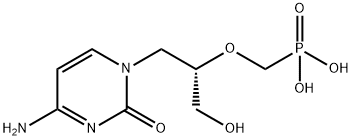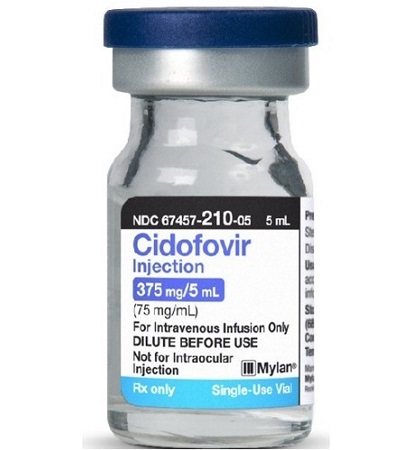
Cidofovir
- Product NameCidofovir
- CAS113852-37-2
- CBNumberCB5492709
- MFC8H14N3O6P
- MW279.19
- EINECS638-807-0
- MDL NumberMFCD00866936
- MOL File113852-37-2.mol
- MSDS FileSDS
Chemical Properties
| Melting point | 260° (dec) |
| alpha | D20 -97.3° (c = 0.80 in water) |
| Boiling point | 609.5±65.0 °C(Predicted) |
| Density | 1.76±0.1 g/cm3(Predicted) |
| storage temp. | Keep in dark place,Sealed in dry,Store in freezer, under -20°C |
| solubility | deionized water: ≥5mg/mL (warmed) |
| form | powder |
| pka | 2.29±0.10(Predicted) |
| color | White to off-white |
| Water Solubility | Soluble to 12 mg/mL (42.98 mM) in Water |
| InChI | InChI=1S/C8H14N3O6P/c9-7-1-2-11(8(13)10-7)3-6(4-12)17-5-18(14,15)16/h1-2,6,12H,3-5H2,(H2,9,10,13)(H2,14,15,16)/t6-/m0/s1 |
| InChIKey | VWFCHDSQECPREK-LURJTMIESA-N |
| SMILES | P(CO[C@H](CO)CN1C(=O)N=C(N)C=C1)(=O)(O)O |
| CAS DataBase Reference | 113852-37-2(CAS DataBase Reference) |
| NCI Dictionary of Cancer Terms | cidofovir |
| FDA UNII | 768M1V522C |
| NCI Drug Dictionary | cidofovir |
| ATC code | J05AB12 |
Safety
| Symbol(GHS) |

|
|||||||||
| Signal word | Danger | |||||||||
| Hazard statements | H301-H315 | |||||||||
| Precautionary statements | P301+P310+P330-P302+P352 | |||||||||
| Hazard Codes | T | |||||||||
| Risk Statements | 25-38 | |||||||||
| Safety Statements | 36-37-45 | |||||||||
| RIDADR | UN 2811 6.1 / PGIII | |||||||||
| WGK Germany | 3 | |||||||||
| RTECS | SZ6545000 | |||||||||
| Hazardous Substances Data | 113852-37-2(Hazardous Substances Data) | |||||||||
| NFPA 704: |
|



